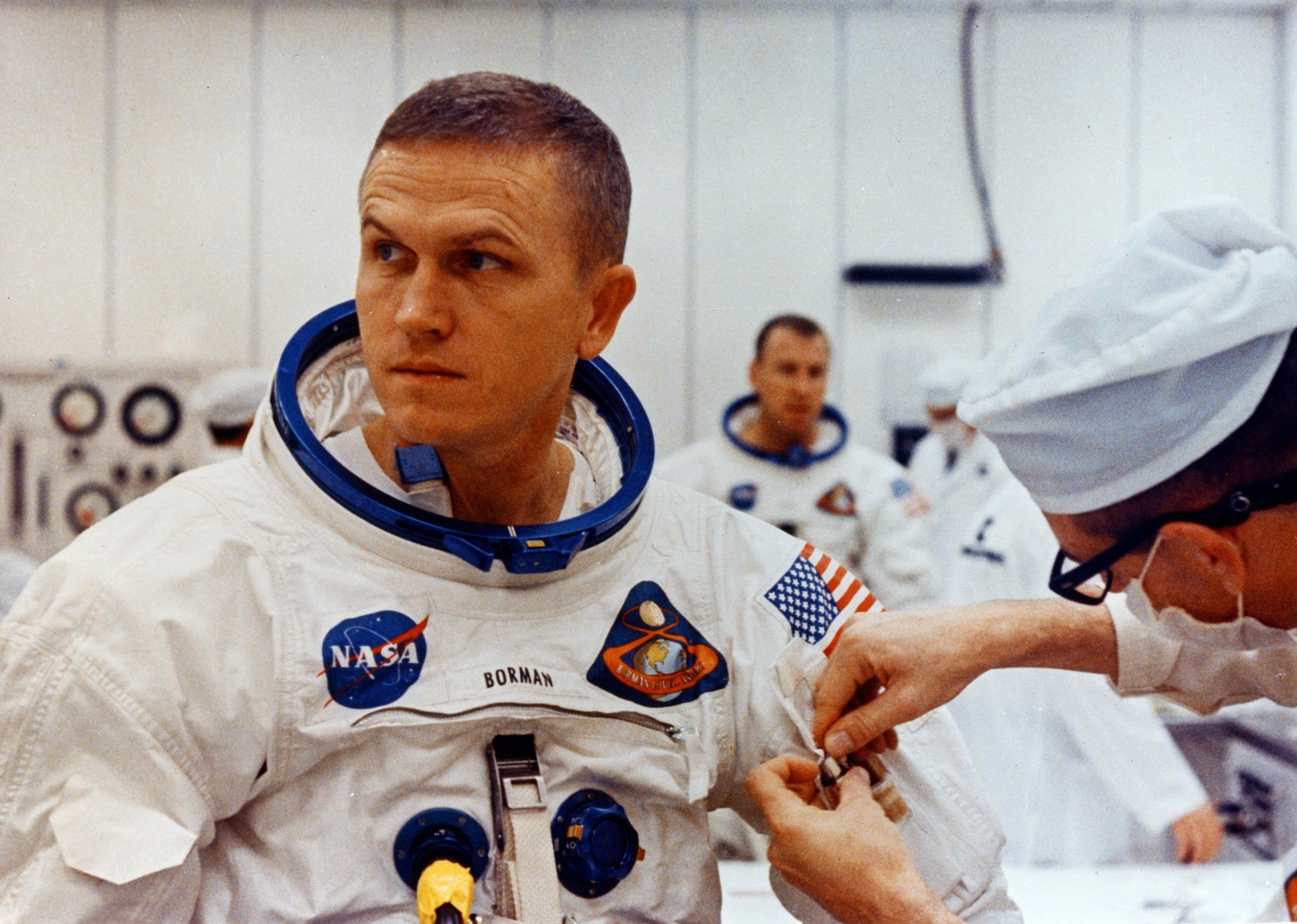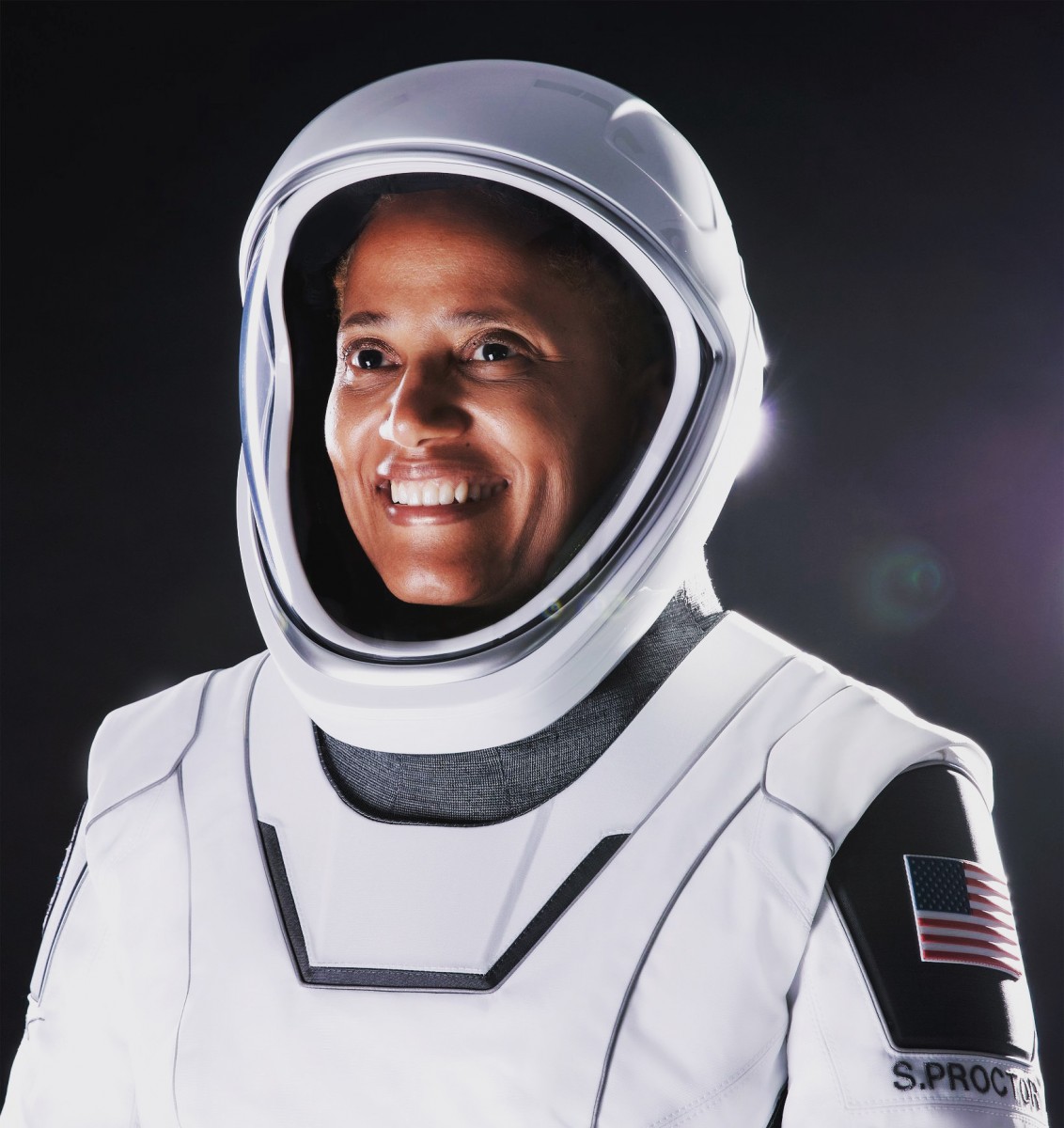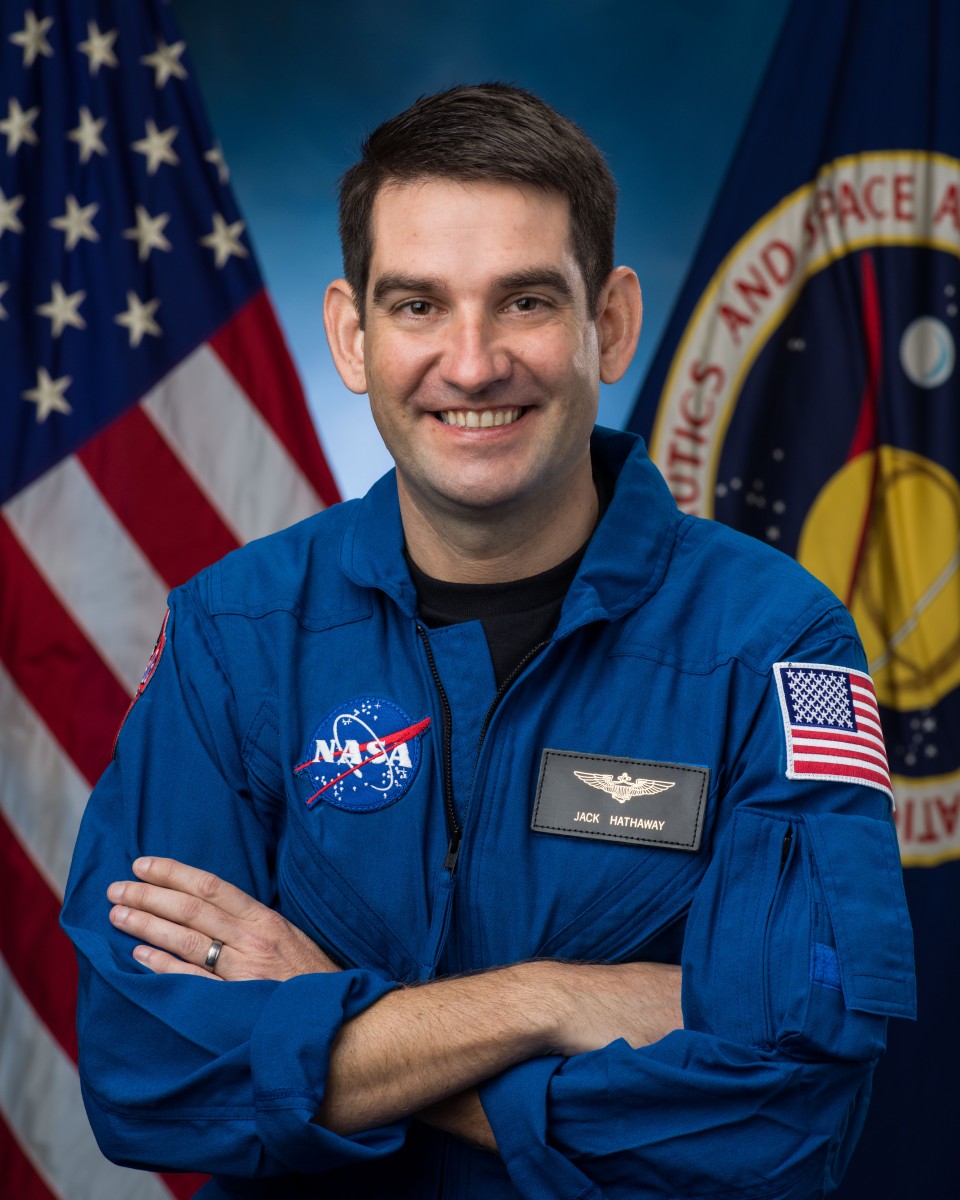Celestial Bodies: CAP Astronauts from the Past to the Future
From NASA’s Mercury 7 astronauts to the SpaceX Inspiration4 mission and beyond, a thread woven through Civil Air Patrol history parallels the progress of America’s space program. Several CAP cadets went on to fulfill their dreams of spaceflight, and many NASA astronauts were named honorary members of CAP. Today, one astronaut candidate and a CAP cadet are still working toward that dream.
Mercury 7
The Mercury 7 were the original group of U.S. astronauts chosen to fly in the first human spaceflight program. Six total flights were  conducted, starting with Alan Shepard Jr.’s 15-minute suborbital mission May 5, 1961, and ending with Gordon Cooper Jr.’s 34-hour mission May 15-16, 1963, during which spacecraft Faith 7 completed 22 orbits to evaluate the effects of one day in space.
conducted, starting with Alan Shepard Jr.’s 15-minute suborbital mission May 5, 1961, and ending with Gordon Cooper Jr.’s 34-hour mission May 15-16, 1963, during which spacecraft Faith 7 completed 22 orbits to evaluate the effects of one day in space.
In December 1963, at a meeting of the CAP National Executive Committee, Col. Paul C. Ashworth, CAP national commander, presented plaques to Maj. Donald “Deke” Slayton recognizing the Project Mercury astronauts for “their courageous contribution to the scientific exploration of space.” The seven original astronauts were given honorary CAP memberships, a practice that continued with Gemini and Apollo crews.

Gemini 7
Col. Frank Borman was a Civil Air Patrol cadet in the Arizona Wing and began flying in Tucson when he was 15. He worked in retail stores to pay for his flying lessons. “It took a week’s work to pay for one flying lesson on Sunday,” he said.
Borman, who graduated from West Point in 1950, became interested in space in 1957 when Russia orbited the first Sputnik. Already a U.S. Air Force jet pilot, Borman enrolled in the Air Force Experimental Flight Test Pilot School at Edwards Air Force Base, California, and qualified as a test pilot, one of the requirements for astronaut program applicants. He was accepted as one of five students in the first class at the Aerospace Research Pilot School, graduating in 1960.
U.S. Air Force jet pilot, Borman enrolled in the Air Force Experimental Flight Test Pilot School at Edwards Air Force Base, California, and qualified as a test pilot, one of the requirements for astronaut program applicants. He was accepted as one of five students in the first class at the Aerospace Research Pilot School, graduating in 1960.
He was selected for the second group of astronauts in 1962 and made his first flight on Gemini 7 with Navy Capt. James Lovell in December 1965. Borman and Lovell became honorary members of CAP just before the flight. Gemini 7 spent nearly two weeks in space, making 206 orbits of Earth.
Apollo 8 In December 1968 Borman commanded the Apollo 8 mission, the first to orbit the moon. The crew for that mission also included Lovell and Air Force Maj. William Anders, who became an honorary Civil Air Patrol member in early December 1968 during a ceremony in Houston. Maj. Gen. Walter B. Putnam, CAP national commander, accompanied by two CAP cadets, presented a specially designed CAP flag to the Apollo 8 crew along with an organizational charter designating them the “Apollo 8 Squadron.”
In December 1968 Borman commanded the Apollo 8 mission, the first to orbit the moon. The crew for that mission also included Lovell and Air Force Maj. William Anders, who became an honorary Civil Air Patrol member in early December 1968 during a ceremony in Houston. Maj. Gen. Walter B. Putnam, CAP national commander, accompanied by two CAP cadets, presented a specially designed CAP flag to the Apollo 8 crew along with an organizational charter designating them the “Apollo 8 Squadron.”

Space Shuttles Columbia, Discovery, and Endeavour
Mike Lounge, also a Civil Air Patrol member, flew as a mission specialist on Space Shuttle Discovery in August 1985 and again in September 1988, the first flight after the 1986 Space Shuttle Challenger accident.
Lounge presented a memorial plaque commemorating the Challenger crew to Brig. Gen. E. E. Harwell, CAP national commander, during the CAP National Board meeting in Salt Lake City in 1988.
Lounge also served as the flight engineer on Space Shuttle Columbia in December 1990, before leaving the astronaut corps in June 1991.

Eric Boe belonged to the Georgia Wing’s Atlanta Composite Squadron, earning the Gen. Carl A. Spaatz Award, CAP’s top cadet achievement, in 1983. He attended the Air Force Academy and was honored as the former CAP cadet graduating highest in order of merit in the class of 1987.
 Following graduation, Boe was assigned to the prestigious Euro-NATO Joint Jet Pilot Training Program at Sheppard Air Force Base, Texas, where he earned his pilot wings after a year of intensive ground school and flight training.
Following graduation, Boe was assigned to the prestigious Euro-NATO Joint Jet Pilot Training Program at Sheppard Air Force Base, Texas, where he earned his pilot wings after a year of intensive ground school and flight training.
Boe said his involvement with Civil Air Patrol in his youth helped him achieve his career goals of becoming a fighter pilot and an astronaut. He soloed at age 16 at a Georgia Wing flight encampment, and he credits his cadet experience for his desire to fly. “That was my first real opportunity to fly an airplane by myself,” he said. “CAP gave me that opportunity, and it really made a difference in the long term. It’s always nice to have flown before you show up at pilot training.”
NASA selected Boe as a pilot in 2000, and he spent two years in training. After that, he held a variety of positions, including one year as NASA director of operations at the Gagarin Cosmonaut Training Center in Star City, Russia, and four years as deputy chief of the astronaut office. During those years, he was assigned to two space shuttle missions, piloting a 16-day flight aboard Endeavour in November 2008 and spending 13 days on Space Shuttle Discovery for its final flight in February-March 2011.
In 2015, Boe was named one of four astronauts who trained to fly commercial crew flight tests in 2017 aboard the Boeing CST-100 and SpaceX Crew Dragon. He is the assistant to the chief for commercial crew in the astronaut office at NASA Johnson Space Center.
Boe remains a member of CAP in the Texas Wing.

Inspiration4
Another member of CAP trained to fly the SpaceX Crew Dragon last year and realized her lifelong dream of going into space. Sian Proctor, a member of the Arizona Wing’s Sky Harbor Composite Squadron, spent three days orbiting Earth as the mission pilot on the privately funded
Proctor, a member of the Arizona Wing’s Sky Harbor Composite Squadron, spent three days orbiting Earth as the mission pilot on the privately funded
Inspiration4 flight in September. Proctor is an active contributor to the Arizona Wing aerospace education team, a professor at South Mountain Community College in Phoenix, a geoscientist, an analog astronaut, and a space artist and poet.
Proctor’s father encouraged her to join Civil Air Patrol in her early teens. “My dad, who knew I wanted to be a military aviator and go to the Air Force Academy, told me about the Civil Air Patrol and asked me if I wanted to join,” Proctor recalls. “I became a member of the Rochester Composite Squadron in New York, and it was fantastic.“
When poor eyesight derailed her dream of attending the Air Force Academy to become a pilot, Proctor’s life took a different path. She earned a bachelor’s degree in environmental science, a master’s in geology, and a doctorate in curriculum and instruction: science education.
Proctor applied three times to join NASA’s astronaut corps and came close to selection in 2009. She competed against more than 3,500 applicants and was chosen as one of 47 finalists.
CAP members, especially cadets, in the Arizona Wing have long benefited from presentations in which Proctor shares her passion for science, space, and exploration. Proctor said she wanted to give back to a program she valued as a teenager and remains committed to as an adult.
“Having achieved the pinnacle of my life’s goals, I’m now in a position to inspire others, which is just as important,” Proctor told Ms. magazine in a postflight interview.

Future Astronauts
Two more CAP cadets — one former, one current — share the dream of becoming an astronaut.
Navy Cmdr. Jack Hathaway was named a NASA astronaut candidate in December and reported to begin his training at Johnson Space Center in January.
Growing up in South Windsor, Connecticut, Hathaway always dreamed of learning to fly and had the opportunity to do so as a CAP cadet. When he was young, Hathaway decided he wanted to attend the Naval Academy because “lots of Navy pilots became astronauts.” He graduated with a bachelor’s in physics and history in 2004.
An F/A-18 pilot, Hathaway has over 2,500 flight hours in 30 types of aircraft and more than 500 carrier-arrested landings, and he flew 39 combat missions. As an adult, he said, he came to appreciate how complex his career choice is and added that he looks forward to the challenge of doing the work to become a NASA astronaut.
Cadet Lt. Col. Sanmathi Priya Abiram Lakshmi Devi is a member of the New Jersey Wing’s Capt. “Bud” Jackson Composite Squadron in Edison. A visit to the Kennedy Space Center when she was 7 sparked her interest in becoming an astronaut.

Abiram joined Civil Air Patrol in May 2018 as an eighth-grader. After graduating from high school this year, studying aerospace engineering in college is the next step on her path to becoming an astronaut. “CAP has shaped every aspect of my personality as I grew throughout high school and has been the strongest steppingstone to explore further endeavors as an aspiring astronaut,” Abiram said.
She has participated in a wide range of activities related to science, technology, education and math (STEM) in CAP, including leading a StellarXplorers space systems design team in the Air Force Association-sponsored competition and mentoring a team for the Air Force Agility Prime electric vertical takeoff and landing aircraft design competition.
“My passion for becoming an astronaut inspires me every day,” Abiram said. “There is so much unknown and so much potential for discovery beyond the horizon. They say, ‘the sky is the limit,’ but I would say it’s just the beginning of an infinite world and there are so many corners we haven’t touched yet.
“Space has applications in all areas of life, and it’s really inspiring to me.”
Many more stories will likely be told of aspirations and inspiration — all flowing from CAP members with dreams of spaceflight.
_____
Maj. Margot Myers
Public Affairs Officer
Arizona Wing
This article appears as the cover feature of the Spring 2022 issue of Civil Air Patrol Volunteer, CAP's biannual magazine.


